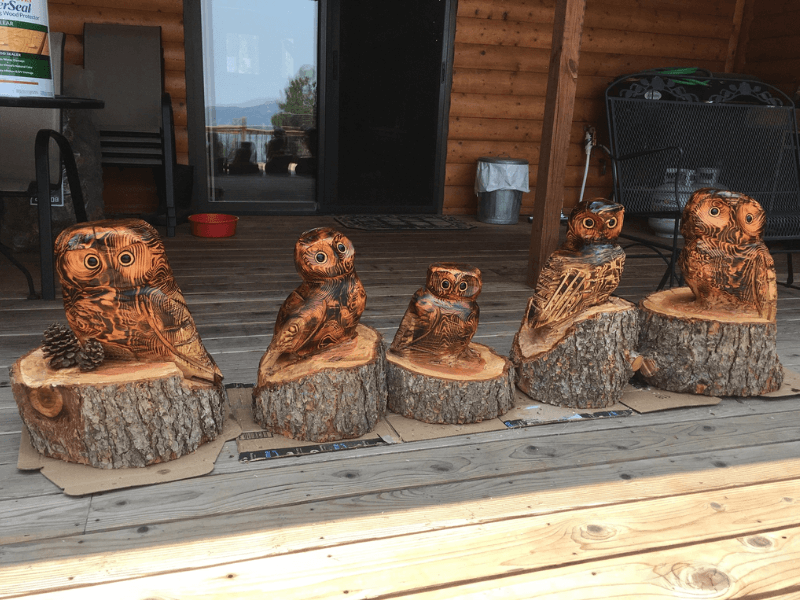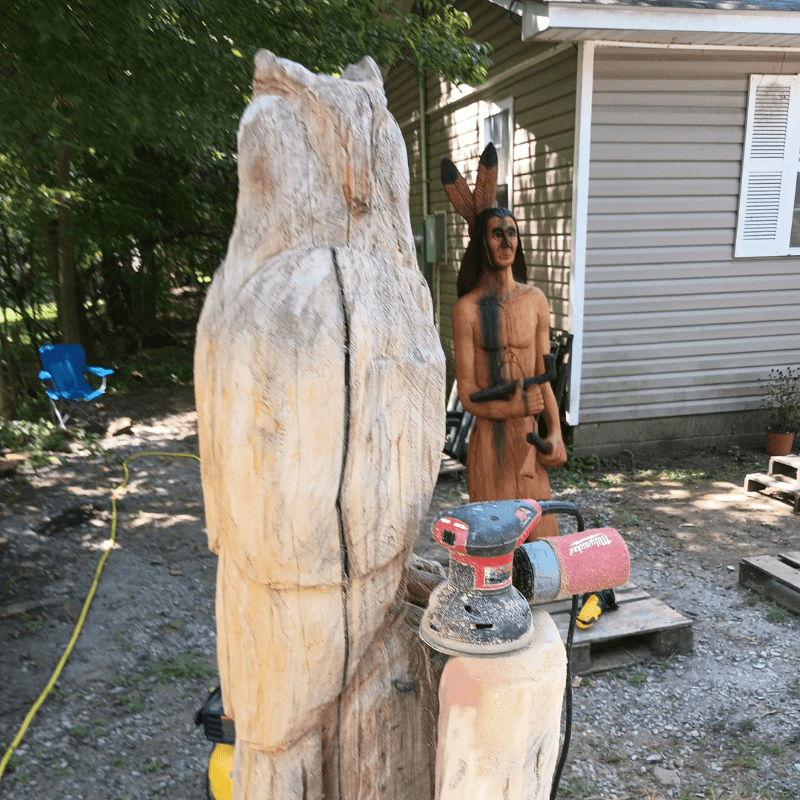In the wood carving finishing article, I covered several reasons why finishing your wood carving is essential. Apart from enhancing their beauty, finishing a wood carving helps protect it from different elements, such as harsh UV rays, changes in temperature and humidity, and much more.
If your wood carving is going to sit outdoors, you must take the necessary steps to ensure you preserve its life. This should help it retain its color and avoid degradation and cracking over time. Below are some methods to protect wood carvings outdoors and how to go about it.
1. Apply Wood Preserver
A wood preservative helps extend the life of your carved wood by preventing rot and decay caused by different elements such as humidity, algae, fungi, and boring insects. When a wood carving is placed outside, exposure to these elements is a must, which is why a wood preserver works best in keeping some elements, such as algae, fungi, and wood-boring insects, at bay.
The Rust-Oleum Woodlife classic preservative is a great product I use to protect my chainsaw wood carvings from biological elements. It also slightly protects against water damage by repelling water, but a wood sealer top coat would be better suited for that task.
It's easy to apply and will protect your wood carving from mold, mildew, and fungi to prevent rotting and decay.
Wood preservatives will protect your wood carvings only from biological threats. However, a wood sealer is the way to go to protect your carving against elements such as humidity and rainwater.
2. Apply a Sealer
Once you’ve applied your wood preservative, it’s time to apply a top coat sealant. A wood sealant seals the wood from outside elements such as rain, humidity changes, and harsh UV rays from the sun. Because sun degradation is common for outdoor wood products, most wood sealers include UV inhibitors that help repel or absorb the sun’s rays and turn them into heat.
There are different types of wood sealers that range from waxes and oils to urethanes. Oil and wax wood sealers are good for indoor wood carvings because they can’t withstand the harsher outdoor elements. A urethane sealer, like spar varnish and water-based polyurethane, is your best bet for outdoor wood carvings.

Sealed Chainsaw Wood Carvings
Spar varnishes make one of the best sealants for outdoor use because they will not only protect your wood carving but will allow some flexibility and UV protection. This keeps elements from destroying your wood carving and prevents cracking or splitting. Spar varnish is different from varnish because it contains more oils, better resins for outdoor use, and UV additives to block harsh UV rays.
The Minwax Helmsman water-based spar urethane is my favorite for wood carvings. The good thing is that it can be used indoors or outdoors. It protects your carving against sunlight, water, humidity, and temperature changes.
3. Avoid the Carving Touching Ground
If you want your outdoor wood carvings to last longer, you should avoid placing them on the ground. This is very straightforward because placing them on the ground introduces a range of elements that can cause the carving to be destroyed faster. Whether it is termite damage, water damage, or mold and other fungi exposure, ground contact for wood carvings should be minimized.
Instead of placing your wood carving on the ground, build a concrete pad where the carving can sit securely. Apart from a concrete pad, anything with good drainage and airflow underneath will do.
If it’s a must if your wood carving sits on the ground or even goes into the ground, then you’ll need a better wood preservative. The Rust-Oleum Woodlife Coppercoat is a good preservative for wood below ground. However, depending on exposure, it imparts a green hue on your wood carvings, which can take longer to fade off.
4. Regularly Treat and Seal
Once you’ve set up your wood carving outside, proper maintenance is crucial to ensure longevity. Preservatives and sealers will wear down after being exposed to different outdoor elements such as rain, harsh UV rays, temperature changes, and much more. As time goes on, you’ll notice cracking and surface graying as these elements work their way into the wood.
Regular maintenance after a period of time is important to keep the wood in good shape. This will keep the preservative active and sealer in good shape to prevent water, moisture, or harsh UV rays from penetrating the wood.

Repairing a Chainsaw Wood Carving Before Sealing
5. Make Repairs on Time
Once placed outdoors, changes in humidity and temperature will also cause changes in the structure of the wood. As the wood changes, it will crack or split open. Cracks and splits in a wood carving are major problems, especially outdoors, if left unchecked.
If you notice a crack or split, make sure you repair it as soon as possible to avoid further damage. An outdoor wood filler, such as Abatron WoodEpox Kit, is easier to use and takes a shorter time to fully dry. For severe wood carving cracks, pour liquid epoxy or use Dutchmen and wooden plugs.

